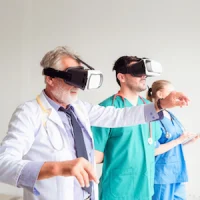The radiologist has always been considered the "doctor's doctor," advising referring clinicians. Recently there has been a shift in the care continue thrusting radiologists onto centre stage where they serve patients directly. The new norm in radiology is in the approach of patient-centred care. Physicians and healthcare providers 'team up' with patients and their families to discern and address the patients' needs and preferences.
In a study published in JACR, researchers found patient portals are a very efficient means for patients to communicate with radiologists and for radiologists to practice patient-centred care. Yet, most health care systems do not provide patients with this option. The purpose of this new project was to develop a method within the electronic medical record (EMR) online patient portal for patients to communicate with radiologists directly.
Most radiology societies have started creating and promoting patient-centred care initiatives, including the RSNA's Radiology Cares and the ACR's Imaging 3.0 programs that strive to make radiologists more visible to patients and help increase the value of radiologists contribution to the health care system and patient care continuum.
You may also like: Machine Learning can automate charting using patient-doctor conversations
The use of online patient portals has expanded in recent years. In 2015, 92% of US hospitals offered patients the option to view their medical records online, and 63% allowed patients to send messages to their health care providers. Patients have expressed a strong desire to have direct access to their radiology reports but are frequently unable to understand them. A large academic health centre analysis found approximately 3% of all patient-originating messages through their online patient portal were related to radiology studies. Although patients generally want to speak with their own physicians about results of radiology studies, many physicians not well equipped to answer specific imaging questions if it is out of their area of expertise. Additionally, patients’ second most preferred method to understand an imaging study’s result is to ask a radiologist.
Interventions
Setting
The project took place in the radiology department of a large academic children’s hospital that uses an integrated EMR with a pre-existing, built-in online patient portal system (Epic, MyChart; Epic Systems, Verona, Wisconsin). The project was exempted from Institutional Review Board review as a quality improvement initiative.
Pre-existing Workflow
Before kicking off the project, patients and their family members were able to see their radiology reports within the EMR portal. Institutional policy makes reports for radiographs, fluoroscopy, ultrasound, interventionalradiology, and most nuclearmedicine studies immediately available; however, reports for CT, MRI, and PET/CT studies are embargoed for 48 hours. If a patient or parent has a question about an imaging study, they can address a question to the ordering provider through the messaging section of the portal, not directly from where the radiology report is viewed.
Gathering Requirements
A working group consisting of the chair of radiology informatics, lead systems analyst of radiology, senior EMR analyst, and a paediatric radiology fellow developed specifications for the system, which were adapted over time to work within the confines of the functionality available via the existing patient portal system.
Creation of a New Workflow
Even though one requirement was to help patients initiate a question directly from the radiology report, this function was not possible because of the confines of the system. Instead, a link to the messaging form was placed in the section where patients view all their test results. Once clicked, the question form is launched. Patients enter the type of study, whether it has already been completed or is a future study, the date of the study (if applicable), and how they would like to be contacted (either by phone or as a response via the patient portal). A question was included as to how the patient had heard about the ability to send messages to radiologists to track effects of marketing efforts over time.
With the existing patient messaging system, it was not possible for patients to send messages directly to the radiologist who interpreted the study, and it was surmised that most of the questions could be answered by any radiologist and not just the one who interpreted the study. Furthermore, a message could sit in a single radiologist’s inbox for an extended period of time if the radiologist was out of town or not actively checking the EMR for new messages for other reasons. Thus, a pool of radiologists was created that consisted of all radiology faculty and fellows (36 and 11, respectively, during the study period) for a total of 47 radiologists. Residents were not included as they typically only spend 1 to 2 months per year within the department.
Messages go to the EMR inbox of all radiologists within the department. Individual radiologists can “claim” the message to minimise duplication of work. The radiologist responsible can reply immediately electronically, document a phone conversation, or forward the encounter to a referring provider for feedback and then reply. The patient message and either the response or documentation of the phone call are available in the EMR to be viewed by other providers outside of radiology.
Promotions made to increase patient awareness of the new system included a message on the login page of the EMR portal, a departmental blog post and Facebook post, and a general awareness campaign in the radiology waiting room.
The number and type of patient questions, preferred means of contact, and how the patient heard about the form were tracked over time. The radiologist responding to the message and the turnaround time from the time the message was received until the response was sent were also tracked.
Outcomes
A messaging system that fulfilled five of seven initial system requirements went live on October 3, 2017. The first message was received on October 4, 2017. Questions submitted between October 3, 2017, and July 31, 2018, were tracked and categorised for inclusion in the study report publication.
On October 17, 2017, an announcement was made on the landing page of the patient portal. On November 17, 2017, a post was made on the departmental blog. On December 7, 2017, the blog post was promoted on Facebook and Twitter.
Over the 301 days of analysis, 168,452 studies were performed on 69,500 patients. Approximately 83,100 patients were active on the online portal during this time. A total of 88 questions were received, representing 0.13% of patients seen in the department; 99% (86 of 88) of questions pertained to already completed studies. Because the form is located on the page of the portal that lists results of already completed studies, it is unlikely that patients would know to look in this location if they have a question about a future study. If the question form were located in the scheduling section of the portal, we believe that we would receive more questions before imaging.
The most frequent questions concerned when results would be available, requests to view images, and questions asking to clarify imaging findings or reports. There were 17 unanswered questions that were mostly related to either another (non-radiologist) provider already answering the question or the family responding to the original radiologist thanking him or her for the initial response.
One of the major limitations of the system is related to the pool of radiologists, which is akin to having multiple people share an e-mail inbox. Once a message is viewed by one radiologist, it is marked as viewed for everyone else in the pool. For example, if a neuroradiologist reviews a message and determines that the question is related to an abdominal imaging study, it is no longer tagged as an unread message. The abdominal radiologist may then assume that there are no patient questions to answer because there are no “unread” messages. Even though radiologists can change a message back to the unread status, this workflow is not intuitive and has led to some messages being left unanswered.
Although there was initial skepticism among the radiologists about the perceived increased responsibility and potential to contradict referring physicians, perception after implementation has overall been positive, and 70% (33 of 47) of the radiologists within the pool have used the system to respond to questions with a median turnaround time of 5.1 hours. Several of the radiologists have anecdotally reported satisfaction with being able to improve patients’ and families’ understanding of their radiology reports.
This project has not only allowed us to better engage our patients but has also provided valuable insight into what our patients think about our practice. For example, 47% of the questions have been related to patients obtaining their results or their images, which suggests that our communication strategy around when results are available and how patients can obtain their images could be improved.
The study report concludes, the creation of an online messaging tool to allow patients to directly communicate with radiologists through an online portal is feasible with commercially available software. In the future, the researchers plan to continue to advertise the portal as a means for patients to communicate with radiologists. They state that their hope is to be able to expand the functionality of the communication tool as the technology of the patient portal is upgraded and expanded.
Source: JACR
Image credit: iStock
References:
A.J. Gunn, M.D. Mangano, G. Choy, D.V. Sahani (2015) Rethinking the role of the radiologist: enhancing visibility through both traditional and nontraditional reporting practices. Radiographics, 35, pp. 416-423
J.N. Itri (2015) Patient-centered radiology. Radiographics, 35, pp. 1835-1846
J.L. Kemp, M.C. Mahoney, V.P. Mathews, M. Wintermark, J. Yee, S.D. Brown (2017) Patient-centered radiology: where are we, where do we want to be, and how do we get there? Radiology, 285, pp. 601-608
J.V. Rawson, L. Mitchell, L. Golden, A. Murdock, G.R. Haines (2016) Lessons learned from two decades of patient- and family-centered care in radiology, part 1: getting started. J Am Coll Radiol, 13, pp. 1555-1559
J.V. Rawson, L. Mitchell, L. Golden, A. Murdock, G.R. Haines (2016) Lessons learned from two decades of patient- and family-centered care in radiology, part 2: building a culture. J Am Coll Radiol, 13, pp. 1560-1565
RSNA. Patient-centered care. Available at: https://www.rsna.org/practice-tools/patient-centered-care, Accessed 6th Feb 2019
P.H. Ellenbogen (2013) Imaging 3.0: What is it? J Am Coll Radiol, 10, p. 229
American Hospital Association. Individuals' ability to electronically access their hospital medical records, perform key tasks is growing. TrendWatch. Available at: https://www.aha.org/system/files/research/reports/tw/16jul-tw-healthIT.pdf. Accessed February 6, 2019.
TrendWatch. Expanding electronic patient engagement. American Hospital Association Annual Survey IT Supplemental Brief 1. Available at: https://www.aha.org/system/files/2018-03/expanding-electronic-engagement.pdf. Published March 2018. Accessed July 2, 2018.
D. Henshaw, G. Okawa, K. Ching, T. Garrido, H. Qian, J. Tsai (2015) Access to radiology reports via an online patient portal: experiences of referring physicians and patients. J Am Coll Radiol, 12, pp. 582-586.e1
M. Cabarrus, D.M. Naeger, A. Rybkin, A. Qayyum (2015) Patients prefer results from the ordering provider and access to their radiology reports. J Am Coll Radiol, 12, pp. 556-562
M. Kuhlman, M. Meyer, E.A. Krupinski (2012) Direct reporting of results to patients. Acad Radiol, 19, pp. 646-650
M.I. Mityul, B. Gilcrease-Garcia, A. Searleman, J.L. Demertzis, A.J. Gunn (2018) Interpretive differences between patients and radiologists regarding the diagnostic confidence associated with commonly used phrases in the radiology report. AJR Am J Roentgenol, 210, pp. 123-126
B.M. Mervak, M.S. Davenport, K.A. Flynt, E.A. Kazerooni, W.J. Weadock (2016) What the patient wants: an analysis of radiology-related inquiries from a web-based patient portal. J Am Coll Radiol, 13, pp. 1311-1318
S. Woolen, E.A. Kazerooni, A. Wall, et al. (2016) Waiting for radiology test results: patient expectations and emotional disutility. J Am Coll Radiol, 15, pp. 274-281
R. Gefen, M.A. Bruno, H.H. Abujudeh (2017) Online portals: gateway to patient-centered radiology. AJR Am J Roentgenol, 209, pp. 987-991
S. Ranginwala, A.J. Towbin (2017) The power of promotion: using social media to promote a radiology department. Acad Radiol, 24, pp. 488-496
M. McBee Do you have a question for a radiologist? Cincinnati Children’s Blog Available at: https://blog.cincinnatichildrens.org/radiology/do-you-have-a-question-for-a-radiologist/, Accessed 7th Jun 2018
Latest Articles
The radiologist has always been considered the "doctor's doctor," advising referring clinicians. Recently there has been a shift in the care continue thrusting radiologists onto centre stage where they serve patients directly. The new norm in radiology is in the approach of patient-centred care. Physicians and healthcare providers 'team up' with patients and their families to discern and address the patients' needs and preferences.
The radiologist has always been considered the "doctor's doctor," advising referring clinicians. Recently there has been a shift in the care continue thrus...










